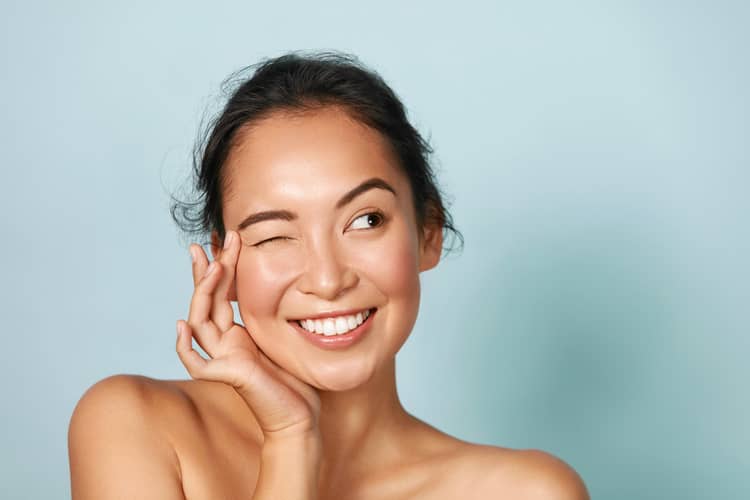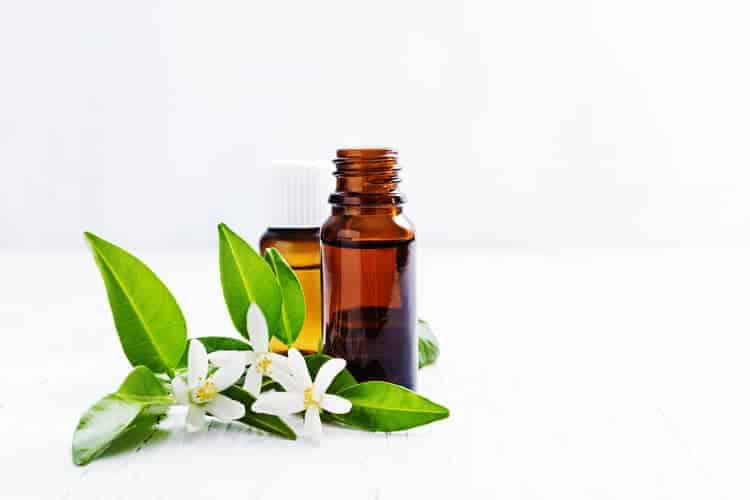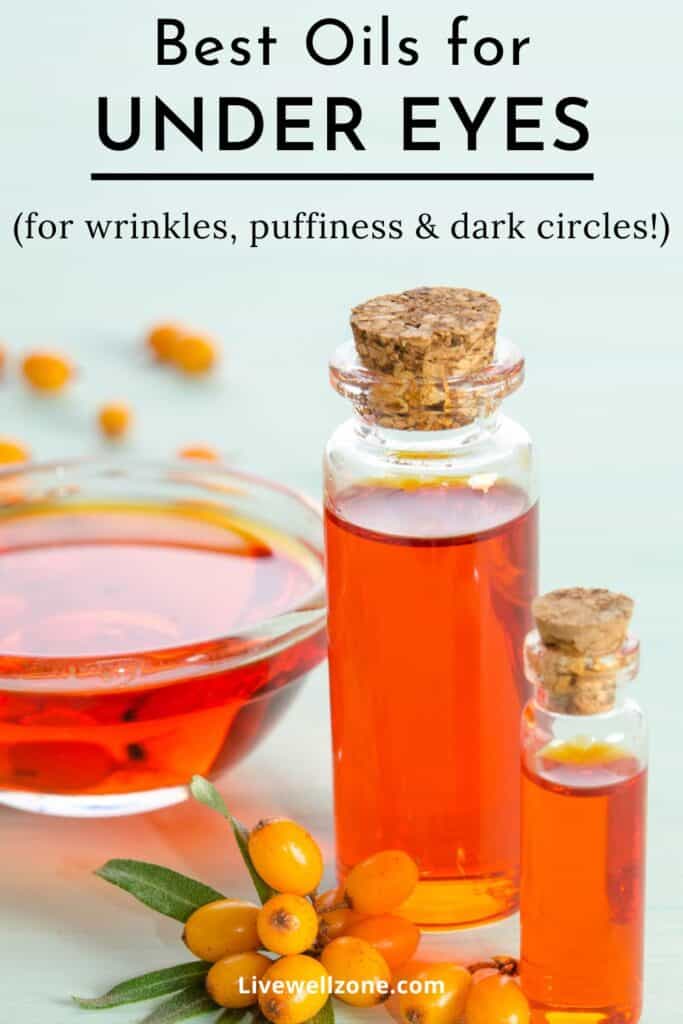
Ever wondered if the skin around the eyes needs different oils from the rest of your face, and if so, what are the best oils for under eyes? Well, you’re in the right place because this article will give you the scoop on:
- Things to consider when choosing oils for the eye area.
- Carrier oils to use around the eyes.
- Some essential oils to use around the eyes and safety tips to consider.
Note: this post contains some affiliate links and I earn a commission (at no additional cost to you) if you use them to make a purchase.
HOW TO CHOOSE OILS FOR THE UNDER EYE AREA

Depending on which expert, influencer or brand you listen to, you will get different opinions on whether or not we actually need a special product for the eye area.
In fact, even dermatologists may not insist on the need for an eye-specific product (as I learned almost two decades ago when my derm said that anything safe for the rest of the face is generally safe around the eyes).
That said, there are a couple of things that are definitely different about the skin around the eyes:
- Thickness: the skin around the eyes is thinner than what is on the rest of the face. This means that you don’t want to use anything that is too strong because it could easily affect the health of your eyes.
- Oil glands: the skin around the eyes has less oil glands and subsequently, there’s less sebum to keep the skin soft, supple and lubricated.
So, when choosing oils for the eye area, it’s a good idea to:
- Stick to pure, organic carrier oils such as jojoba, rosehip and so on. You can use them individually or in a blend with other oils.
- Use mostly light to medium weight liquid oils. These are more easily absorbed and less likely to clog pores (which can lead to undesirable side effects like puffiness).
- Avoid essential oils altogether or use them in very small doses. More on this later!
- Be mindful when it comes to herb-infused oils. Consult with a natural skincare specialist or herbalist to help you determine which herbs are actually safe for the eye area.
TOP CARRIER OILS FOR UNDER EYES: REDUCE WRINKLES, PUFFINESS, DARK CIRCLES AND MORE

Some of the best oils for the under eye area include jojoba, rosehip and squalane oil. These oils have anti-inflammatory properties that may help to improve puffiness, dark circles, wrinkles and other skin issues.
NOTE: aside from inflammation, other factors – like nutritional deficiencies, hormone imbalance and stress – can also affect the health of the skin around your eyes.
| CARRIER OIL | BENEFITS |
|---|---|
| Jojoba oil | easily absorbed; soothing emollient; most similar to sebum |
| Rosehip oil | rich in beta-carotene which is converted to vitamin A; easily absorbed; supports collagen production. |
| Squalane oil | very soothing to irritated or inflamed skin; emollient and lightweight. |
| Sea buckthorn oil | rich in omega-7’s; contains beta carotene which is converted to vitamin A. |
| Evening primrose | high in linoleic acid which is essential for skin barrier function. |
| Apricot kernel oil | easily absorbed and natural source of beta carotene; has a silky feel on the skin. |
| Raspberry seed oil | Contains carotenoids (provitamin A) and fatty acids, as well as sterols (natural emollients). |
| Grapeseed oil | Easily absorbed and astringent; contains carotenoids (provitamin A). |
| Olive oil | Contains vitamin K, carotenoids and other antioxidants. |
| Fractionated coconut oil | Light-weight, fast absorbing and less comedogenic than regular coconut oil. |
| Sweet almond oil | Natural source of vitamin E, fatty acids and plant sterols (which keep the skin supple). |
1. Jojoba Oil
Jojoba oil consists mainly of wax esters. These esters also happen to make up about 25% of our sebum. So if there’s one oil that’s closest to your skin’s natural oils, it’s jojoba.
This oil is also:
- A mild occlusive i.e. it forms a protective layer on the skin that prevents excessive water and dryness.
- Easily absorbed by the skin and doesn’t leave a greasy film.
- A natural emollient that softens the skin and keeps it supple.
- Anti-inflammatory, which can help to reduce puffiness.
2. Rosehip Oil
Rosehip oil is a natural source of beta-carotene, which is a carotenoid (antioxidant) that the body converts to vitamin A (source). When used topically, vitamin A helps to:
- Support collagen production.
- Soften wrinkles and fine lines.
- Reduce dark circles and brighten the skin around the eyes.
So, rosehip oil basically gives you many of the same benefits as synthetic vitamin A (like retinol) in a natural form.
In addition, rosehip oil contains vitamin E (antioxidant) and essential fatty acids that support the skin barrier and fight off inflammation.
NOTE: the rosehip seed and fruit pulp provide different benefits/nutrients. I suggest using a rosehip oil that is pressed from the entire fruit (seed and pulp) to get all the benefits.
3. Squalane Oil
If you take a look at popular eye serums and eye creams, you’ll notice that squalane shows up a lot in the ingredients list. And for good reason: this oil is quite gentle, lubricating, locks in moisture and anti-inflammatory (something you need when you’re struggling with puffiness, for example!).
Other benefits of squalane include:
- Lightweight and non-comedogenic.
- Helps balance sebum production.
- Soothes irritated skin.
Now, before you rush out and buy this oil, there are some important things to know about squalane:
- Squalane starts out as squalene.
- For many decades squalene was sourced from sharks. Not surprisingly, that practice fell out of favor and now many companies use squalene from sugar cane and olive oil. That said, always check the label or company’s website to know exactly where the squalene comes from.
- Squalene goes through a hydrogenation process that converts it to squalane. So, technically, the oil has been processed. If you are someone who prefers to avoid all things hydrogenated then you’ll want to skip this oil
4. Sea Buckthorn Oil
Sea buckthorn oil’s biggest claim to fame is that it contains omega 7 fatty acids.
These omega-7 acids are quite rare in nature and one of their main benefits is promoting skin renewal
Aside from the above, sea buckthorn oil is also:
- A natural source of provitamin A (specifically, beta carotene).
- Naturally rich in omega, 3, 6 and 9 fatty acids.
- Anti-inflammatory, antioxidant and non-comedogenic.
NOTE: the sea buckthorn seed and fruit pulp each have different properties and nutrients. To get the full spectrum of benefits, I suggest using a sea buckthorn oil that has been pressed from the seed and pulp.
5. Evening Primrose Oil
Evening primrose oil has about 73% linoleic acid, which is a fatty acid that is essential for the skin barrier. Having a healthy skin barrier is essential for preventing moisture loss and protecting the skin from environmental damage.
Furthermore, evening primrose oil has anti-inflammatory and antioxidant properties that can be particularly soothing for sensitive skin.
6. Apricot Kernel Oil
Apricot kernel oil contains provitamin A (beta-carotene) and vitamin E, both of which are very nourishing to the delicate skin around the eyes.
In addition, apricot kernel oil is a natural source of vitamin K, which may help to reduce dark circles.
It also has a smooth and slightly silky feel that makes it feel particularly luxurious when used around the eyes.
Furthermore, if the skin around your eyes is very dry, apricot kernel oil just might be what you need. It is quite rich in oleic acid (70%), which tends to be a good match for very dry skin.
7. Raspberry Seed Oil
As a rich source of vitamin E, provitamin A carotenoids and fatty acids (mainly linoleic and linolenic acid) raspberry seed oil is an excellent choice for the delicate skin around the eyes (source).
Raspberry seed oil also contains sterols, which are lipid-based emollients that prevent moisture loss and help to prevent oxidative damage.
8. Grapeseed Oil
Want an ultra lightweight oil that won’t leave any residue around the eyes? Then you can’t go wrong with grapeseed oil.
This oil has a high linoleic acid content (up to 75.3%) and it is packed with a variety of antioxidants, including carotenoids, flavonoids and trans-resveratrol. (source).
As a bonus, grapeseed oil also has astringent properties, meaning it can constrict skin tissue (which might help with swollen or puffy eyes).
9. Olive Oil
Olive oil contains various carotenoids (including beta-carotene), high amounts of oleic acid (55 – 83% depending on the harvest) and low to medium amounts of linoleic acid (3.5 – 21%, depending on the harvest). (1, 2).
Other noteworthy ingredients in olive oil include:
- vitamin K, which might improve dark circles and brighten the eye area.
- Antioxidants like vitamin E, squalene and lutein.
Do keep in mind that olive oil is heavier than some of the other oils on this list.
So, if you’re not a fan of heavy oils, then you can blend it with lighter oils (such as jojoba, rosehip or grapeseed, for example).
10. Fractionated Coconut Oil
Unlike virgin coconut oil, fractionated coconut is light-weight, fast absorbing and less comedogenic.
This is all mainly due to the fact that fractionated coconut oil doesn’t contain the long chain fatty acids (such as lauric acid) that are in virgin coconut oil.
Now, even though fractionated coconut oil is processed it still contains fatty acids like capric acid and caprylic acid, which are antimicrobial.
These fatty acids also help to lock in moisture and keep the skin supple.
11. Almond Oil
Almond oil has a variety of nutrients that can nourish and support the skin around the eyes, such as:
- vitamin E, which provides both emollient and antioxidant benefits for the skin.
- Phenolic compounds such as flavonoids, that are known for having antioxidant activity.
- High amounts of oleic acid (it can be as high as 83%, depending on the variety of almond used for oil extraction).
- Phytosterols, which are cholesterol-like compounds that help to keep the skin supple.
ESSENTIAL OILS THAT ARE GOOD FOR SKIN AROUND THE EYES

Essential oils that are good for the skin around the eyes include lavender, frankincense, rose geranium and carrot seed.
That said, it’s important to remember that essential oils are very potent natural medicines and should be used with caution.
So, if you do choose to use essential oils around the eye area, keep these guidelines in mind:
- Use a lower dilution than what is recommended for the rest of the face. So, in general, a dilution of 1 – 1.5% is standard for the face. But for the eye area, a lower dilution of 0.5% is better. This equates to 1 drop essential oil for every 2 teaspoons of carrier oil.
- Stick to oils that are generally considered safe for the skin. Below is a table that lists those oils and skincare benefits (as documented in the journal Evidence Based Complementary & Alternative Medicine).
- In addition to using skin-safe essential oils, choose only those oils that have high dermal limits (i.e. the maximum dilution that is considered safe for the skin). Generally, oils with a high dermal limit tend to be less irritating and more forgiving if you accidentally use too much.
- Rather than make your own mix at home, consider buying a cream or serum. As long as you’re using a quality brand, they usually do a good job of formulating the product with safe amounts of essential oils.
| ESSENTIAL OIL | BENEFITS |
|---|---|
| Roman chamomile | inflammation, difficult/sensitive skin |
| Frankincense carterii | wrinkles, inflammation, oily skin, mature skin, damaged skin, dry skin, scars. |
| Cedarwood (atlas) | inflammation, greasy and oily skin, cracked skin |
| Neroli | wrinkles, broken capillaries, scars, mature and dry skin |
| Sweet Orange | wrinkles, dry and dull complexion |
| Myrrh | wrinkles, inflammation, cracked skin |
| Carrot seed | wrinkles, toner, mature and dry skin, inflammation |
| Lavender | scars, inflammation, oily skin, |
| Rose geranium | mature skin, dry skin, wrinkles |
TIP: if you take a look at some commercial eye creams you’ll notice that they use coffee beans or caffeine. This is because caffeine is an astringent, which can be beneficial for under eye bags and wrinkles. If you’d like to incorporate caffeine into your at-home skin care routine, add a few drops of coffee essential oil into your favorite carrier oil.
NATURAL OIL PRODUCTS FOR THE EYE AREA
1. Simply Eye Serum

One of the things that stands out about this serum is that it is formulated with two vitamin E-rich oils: sweet almond and hazelnut. Vitamin E’s antioxidant properties are helpful for E content from both oils is helpful for improving signs of oxidative damage (such as discoloration).
In addition, the inclusion of baobab oil in this formula means you’re also getting vitamin A, known for supporting skin renewal.
As a finishing touch, the blend is infused with soothing essential oils like frankincense (one of the very best for wrinkles), rosemary and cypress (it has astringent properties that help to tighten skin).
2. Coffee Eye Lift Serum

The main ingredient in this oil is coffee, which is known for having anti-inflammatory and depuffing properties. In addition, there’s nourishing rosehip, pomegranate, argan and watercress oils to soothe the skin around the eyes.
FAQs ABOUT USING OILS UNDER THE EYES
Is castor oil good for under eyes?
Castor oil is anti-inflammatory, with powerful emollient properties that can soften the skin around the eyes. It also has humectant properties that draw moisture to the skin, further helping to soften and moisturize the skin.
CONCLUSION
Carrier and essential oils contain a variety of nutrients, anti-inflammatory and antioxidant properties that can go a long way toward improving the appearance of the skin under the eyes.
If you’re new to these oils, it’s usually best to start with one oil of each type, so that you can see how it works for you. As you find your favorites, feel free to experiment and make your own blends.
If you need more ideas when it comes to mixing carrier and essential oils, be sure to check the related links below!

You Might Also Enjoy:
Vitamin C vs Squalane: Benefits and How to Use Them for Radiant Skin
Grapeseed Oil vs Rosehip Oil for Skin: Benefits, Which Is Better and Uses
DIY Facial Oil Recipes for Glowing Skin: Acne-Prone, Oily, Dry, Sensitive, Combination & Aging Skin
How To Dilute Essential Oils For Skin: Complete Guide for Face and Body
Essential and Carrier Oils Rich In Vitamin C: What You Should Know
What To Mix (And Not) With Rosehip Oil For Face – The Ultimate Guide
What To Do Before And After Steaming Your Face: A Complete Guide
The Difference Between Rosehip Oil and Rosehip Seed Oil: Benefits, Which To Use and How to Use
DIY Facial Oil Recipes for Glowing Skin: Acne-Prone, Oily, Dry, Sensitive, Combination & Aging Skin
Carrier Oils By Skin Type: How to Choose and Simple List for Beginners

